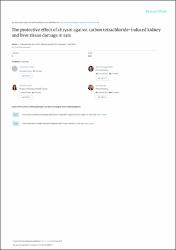The protective effect of chrysin against carbon tetrachloride-induced kidney and liver tissue damage in rats

Göster/
Erişim
info:eu-repo/semantics/openAccessTarih
2020Yazar
Baykalır, Burcu GülArslan, Aslıhan Sur
Mutlu, Seda İflazoğlu
Ak, Tuba Parlak
Seven, İsmail
Seven, Pınar Tatlı
Yaman, Mine
Gül, Hüseyin Fatih
Üst veri
Tüm öğe kaydını gösterÖzet
Abstract: The aim of this study was to investigate the possible protective effects of chrysin on oxidative status and histological alterations against carbon tetrachloride (CCl4)-induced liver and kidney tissue in rats. The animals were randomly divided into four groups; the control, chrysin (100 mg/kg), CCl4 (0.5 ml/kg) and chrysin + CCl4 groups. Liver and kidney injuries were assessed by biochemical and histopathological examinations. The levels of malondialdehyde (MDA), reduced glutathione (GSH), and superoxide dismutase (SOD) activity were measured in tissues. Serum tumor necrosis factor-α (TNF-α), aspartate aminotransferase (AST), alanine aminotransferase (ALT), urea, and creatinine levels were also measured in blood samples. MDA, serum TNF-α, AST, ALT, urea, and creatinine levels (p < 0.05) were significantly higher, and SOD activity and GSH level were significantly (p < 0.05) lower in the CCl4 group than in the control group. Treatment with chrysin in the chrysin + CCl4 group decreased MDA, AST, ALT, creatinine, and TNF-α levels (p < 0.05), and increased SOD activity, GSH levels (p < 0.05), and serum TNF-α levels (p < 0.05). In addition, body weight change (BWC) (p < 0.05) and feed intake (FI) were significantly lower (p < 0.001) in the CCl4 group than in the control group. Moreover, treatment with chrysin increased BWC and FI in the chrysin + CCl4 group compared with that in the CCl4 group. These findings also confirmed by histopathological examination. The chrysin treatment ameliorated the CCl4-induced biochemical and pathological alterations. These results demonstrated that chrysin provided amelioration on the rat liver and kidney tissues CCl4-induced injury by increasing the antioxidant activity.

















